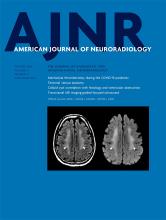Index by author
Hamzei-sichani, F.
- Adult BrainOpen AccessBilateral Basal Ganglia Hemorrhage in a Patient with Confirmed COVID-19R. Daci, M. Kennelly, A. Ferris, M.U. Azeem, M.D. Johnson, F. Hamzei-Sichani, A.H. Jun-O’Connell and S.K. NatarajanAmerican Journal of Neuroradiology October 2020, 41 (10) 1797-1799; DOI: https://doi.org/10.3174/ajnr.A6712
Hasan, D.M.
- NeurointerventionYou have accessQuantifying Intra-Arterial Verapamil Response as a Diagnostic Tool for Reversible Cerebral Vasoconstriction SyndromeJ.M. Sequeiros, J.A. Roa, R.P. Sabotin, S. Dandapat, S. Ortega-Gutierrez, E.C. Leira, C.P. Derdeyn, G. Bathla, D.M. Hasan and E.A. SamaniegoAmerican Journal of Neuroradiology October 2020, 41 (10) 1869-1875; DOI: https://doi.org/10.3174/ajnr.A6772
Heier, L.A.
- FELLOWS' JOURNAL CLUBHead and Neck ImagingOpen AccessOlfactory Bulb Signal Abnormality in Patients with COVID-19 Who Present with Neurologic SymptomsS.B. Strauss, J.E. Lantos, L.A. Heier, D.R. Shatzkes and C.D. PhillipsAmerican Journal of Neuroradiology October 2020, 41 (10) 1882-1887; DOI: https://doi.org/10.3174/ajnr.A6751
This retrospective case-control study compared the olfactory bulb and olfactory tract signal intensity on thin-section T2WI and postcontrast 3D T2 FLAIR images in patients with COVID-19 and neurologic symptoms, and age-matched controls imaged for olfactory dysfunction. Olfactory bulb 3D T2-FLAIR signal intensity was greater in the patients with COVID-19 and neurologic symptoms compared with an age-matched control group with olfactory dysfunction, and this was qualitatively apparent in 4 of 12 patients with COVID-19. Analysis of these preliminary findings suggests that olfactory apparatus vulnerability to COVID-19 might be supported on conventional neuroimaging and may serve as a noninvasive biomarker of infection.
Heiss, J.D.
- EDITOR'S CHOICEAdult BrainOpen AccessTentorial Venous Anatomy: Variation in the Healthy PopulationJ.S. Rosenblum, J.M. Tunacao, V. Chandrashekhar, A. Jha, M. Neto, C. Weiss, J. Smirniotopoulos, B.R. Rosenblum and J.D. HeissAmerican Journal of Neuroradiology October 2020, 41 (10) 1825-1832; DOI: https://doi.org/10.3174/ajnr.A6775
The authors retrospectively reviewed tentorial venous anatomy of the head using CTA/CTV performed for routine care or research purposes in 238 patients. Tentorial vein development was related to the ring configuration of the tentorial sinuses. There were 3 configurations: Groups 1A and 1B had ring configuration, while group 2 did not. Group 1A had a medialized ring configuration, and group 1B had a lateralized ring configuration. Measurements of skull base development were predictive of these groups. The ring configuration of group 1 was related to the presence of a split confluens, which correlated with a decreased internal auditory canal-petroclival fissure angle. Configuration 1A was related to the degree of petrous apex pneumatization.
Herve, G.
- EDITOR'S CHOICEHead and Neck ImagingYou have accessAre Gadolinium-Enhanced MR Sequences Needed in Simultaneous 18F-FDG-PET/MRI for Tumor Delineation in Head and Neck Cancer?N. Pyatigorskaya, R. De Laroche, G. Bera, A. Giron, C. Bertolus, G. Herve, E. Chambenois, S. Bergeret, D. Dormont, M. Amor-Sahli and A. KasAmerican Journal of Neuroradiology October 2020, 41 (10) 1888-1896; DOI: https://doi.org/10.3174/ajnr.A6764
Consecutive patients who underwent simultaneous head and neck 18F-FDG-PET/MR imaging staging or restaging followed by surgery were retrospectively included in this study. Local tumor invasion and lymph node extension were assessed by 2 rater groups in 45 head and neck anatomic regions using 18F-FDG-PET/MR imaging. Two reading sessions were performed, one without contrast-enhanced sequences (using only T1WI, T2WI, and PET images) and a second with additional T1-weighted postcontrast sequences. The k concordance coefficient between the reading sessions and sensitivity and specificity for each region were calculated. There was excellent agreement between the contrast-free and postgadolinium reading sessions in delineating precise tumor extension in the 45 anatomic regions studied. The diagnostic accuracy did not differ between contrast-free and postgadolinium reading sessions, being 0.97 for both groups and both reading sessions. The authors conclude that gadolinium-based contrast administration showed no added value for accurate characterization of head and neck primary tumor extension and could possibly be avoided in the PET/MR imaging head and neck workflow.
Heuer, G.G.
- Pediatric NeuroimagingYou have accessFetal Intraventricular Hemorrhage in Open Neural Tube Defects: Prenatal Imaging Evaluation and Perinatal OutcomesR.A. Didier, J.S. Martin-Saavedra, E.R. Oliver, S.E. DeBari, L.T. Bilaniuk, L.J. Howell, J.S. Moldenhauer, N.S. Adzick, G.G. Heuer and B.G. ColemanAmerican Journal of Neuroradiology October 2020, 41 (10) 1923-1929; DOI: https://doi.org/10.3174/ajnr.A6745
Hildebrandt, F.
- Pediatric NeuroimagingOpen AccessMRI Spectrum of Brain Involvement in Sphingosine-1-Phosphate Lyase Insufficiency SyndromeK.W. Martin, N. Weaver, K. Alhasan, E. Gumus, B.R. Sullivan, M. Zenker, F. Hildebrandt and J.D. SabaAmerican Journal of Neuroradiology October 2020, 41 (10) 1943-1948; DOI: https://doi.org/10.3174/ajnr.A6746
Honda, T.
- Adult BrainYou have accessPerfusion Parameter Thresholds That Discriminate Ischemic Core Vary with Time from Onset in Acute Ischemic StrokeT. Yoshie, Y. Yu, H. Jiang, T. Honda, H. Trieu, F. Scalzo, J.L. Saver, D.S. Liebeskind and on behalf of the UCLA Reperfusion Therapy InvestigatorsAmerican Journal of Neuroradiology October 2020, 41 (10) 1809-1815; DOI: https://doi.org/10.3174/ajnr.A6744
Howell, L.J.
- Pediatric NeuroimagingYou have accessFetal Intraventricular Hemorrhage in Open Neural Tube Defects: Prenatal Imaging Evaluation and Perinatal OutcomesR.A. Didier, J.S. Martin-Saavedra, E.R. Oliver, S.E. DeBari, L.T. Bilaniuk, L.J. Howell, J.S. Moldenhauer, N.S. Adzick, G.G. Heuer and B.G. ColemanAmerican Journal of Neuroradiology October 2020, 41 (10) 1923-1929; DOI: https://doi.org/10.3174/ajnr.A6745








